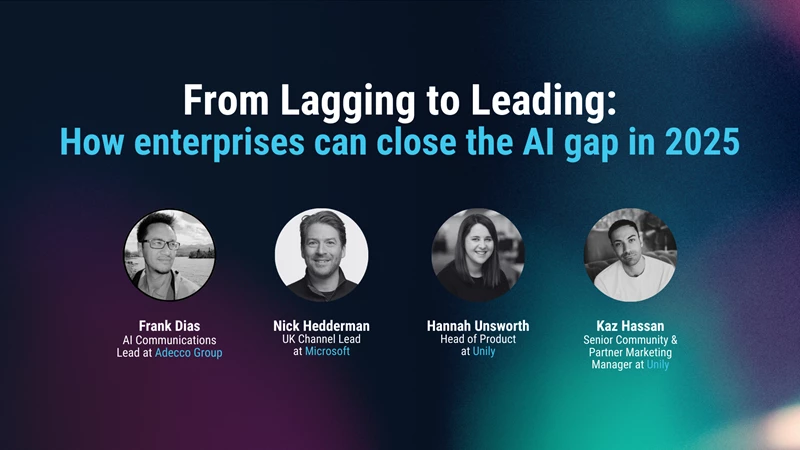7 employee experience trends CIO's should be prepared for in 2021
2021 is just around the corner and CIO’s are faced with the task of making sure their organization can rise to the challenge of ensuring business continuity as the world rides out the pandemic. With the resulting impact of COVID-19 seeing CIO’s having a stronger relationship with the business, CIO’s should be leveraging that influence appropriately and to the organization’s best interests. So, what are the most important trends of 2021 that CIO’s should know, and how does employee experience fit into it all?

The focus on employee experience for CIO's
The pandemic has been a catalyst for change across the globe, but for CIO's in particular it’s had a lasting impact. 80% of CIO's are now seen as influential enough to educate the CEO and other senior stakeholders on the value of IT, and so have the opportunity to play a leading role in digitally accelerating the business.
In the context of digital transformation, employee experience is not just an HR exercise – it’s a business priority. With only 13% of employees stating they are fully satisfied at work, organizations need to take note and make significant investments in their efforts. For CIO's, this should be seen as a priority. The cost of employee unhappiness is huge, not only in the fact that employees with low satisfaction are more eager to change jobs, but financially for the business too – it’s estimated that disengaged employees are costing the UK economy £340 billion every year in lost training and recruitment costs, sick days, productivity, creativity and innovation.
CIO's focused on employee experience will help their firms attract, develop, and retain talent that can provide a competitive advantage in a critical year. Taking this into account, CIO's should be taking note of and investing in the following employee experience trends for the upcoming year ahead.
#1. The importance of investing in the latest technology will continue to increase
It may not seem like the most ground-breaking trend, but the importance of investing in the latest technology will continue to rise along with the ongoing conversations about remote work. It’s predicted that 30% of firms will increase spending on cloud, security and risk, networks, and mobility. CIO's will need to embrace a cloud-first strategy to tie in with the new attitude towards working.
The office as we once knew it has changed forever and companies need to make sure they have the technology necessary to continue to work. Many offices are unlikely to reopen as before, and so CIO's should consider that remote working is here for the long-term and that it’s important employees have everything they need to ensure their working experience is more than satisfactory.
Investing time and money into a digital workplace will make working from home an easier, more collaborative experience. A modern, cloud-based intranet can act as a digital headquarters, enabling all information, tools, applications, and tasks to be centralized onto one platform, raising the productivity of workers by 20 to 25%. Employees can stay connected, up-to-date, and available – no matter where they reside or are working from.
#2. Collaboration tools will reign
42% of CIO's shared that a major challenge of COVID-19 was less visibility and collaboration because of the siloed nature of employees working from their homes. 2021 will see the next generation of collaboration tools and technology, as the significance of employee collaboration continues to strengthen. When combined with a culture that promotes innovation, collaboration technology leads to employees that are 34% happier with their workplace culture.
Not only does it increase happiness, but online collaboration tools and digital workplaces also facilitate increased productivity by up to 30%. With all of these benefits, CIO's should be taking note and looking to invest in the best collaboration tools on the market. A state-of-the-art digital workplace can serve as a user-centric collaboration hub that drives teamwork throughout the enterprise and beyond.
Investing in a fully-featured digital workplace solution with elements such as internal social networking and document management as well as specific collaboration features can mean employee experience is heightened, and workers themselves feel included and cooperative.
#3. Invest in employee wellness and digital reward and recognition (R&R) strategies
Covid-19 has changed leadership and hiring practices forever, with it being estimated that remote work will rise to 300% of pre-COVID levels. Chief among a CIO’s interests will be using technology to boost employee wellness. This will not only help with managing any new compliance issues that are associated with remote working but will also build the employee experience environment companies need as a bridge to post-pandemic work life. 40% of employees would put energy into their work if they were recognized more often, so CIO's should be considering how to combat this and encourage a working culture where employee wellness and recognizing achievements is front and foremost.
Digitizing your R&R strategy is a sure-fire way to encourage positivity in the workplace, and to continue to make sure employees still feel recognized and appreciated despite working disparately. There are many platforms available that can be used to highlight and celebrate employee achievements, but it can sometimes be tricky to encourage employees to adopt and engage with new technology so wholeheartedly.
Instead, CIO's should consider looking to invest in an intranet as a tool for R&R. This means organizations can keep all work-related activities in one place, so users don’t have to learn any new technologies or switch back and forth between tools. Many intranet systems also come with native R&R features embedded, or can easily assimilate 3rd party platforms, helping to drive the success of existing R&R initiatives within the context of a connected digital workplace.

#4. Employee data will become pivotal for decision-making
It’s well-known that data is the life-blood of a business, but what does it have to do with employee experience? Workforce analytics isn’t new, yet it’s growing in importance year-on-year. Being able to understand the performance of your digital workplace – and your employees – is critical for CIO's to look at making business decisions.
53% of organizations reported that their leaders’ interest in workforce information has increased in the past 18 months, showing that the desire for better workforce metrics spans a diverse set of needs to focus on the future. The companies that are more data-driven tend to be the most competitive and productive, so it’s no surprise that interest has increased.
CIO's should be looking at how to best analyze employee data through metrics and analytics gathered from their teams’ interaction with the digital workplace. This helps develop a workforce plan that improves talent investments, while also efficiently monitoring recruiting, development, engagement, productivity, retention, and many other workplace initiatives. In turn, these insights will not only be used to boost employee experience as a whole, but also fuel business decision making and overcoming obstacles that may not have been apparent before.
#5. Consolidation will take center-stage to cut costs
A top priority for CIO’s will be looking at how to best increase IT capability and employee experience, while still cutting costs and ensuring business continuity – especially after a year that has likely tightened a lot of purse strings.
One of the biggest costs for a business is unused technology. It’s estimated that, on average, companies waste nearly $30 billion per year on unused or rarely used software. Having an intranet can help to cut costs by being able to retire duplicate technologies and maximize existing technologies and investments, such as Microsoft Stack.
A modern intranet presents opportunities to consolidate and integrate the disparate tools, applications, technologies, and information the businesses make use of into one centralized system. This saves both time and money for the company, while also benefiting employees who will now have all information they need at their fingertips.
#6. Encouraging higher employee productivity will become a necessity
As CIO’s balance enhancing business outcomes with controlling the costs involved, it’s become more crucial than ever for CIO’s to assess how productive their employees are. Companies with highly engaged employees have a 27% operating margin, so it’s within the CIO’s best interest to encourage productivity and engagement within staff wherever possible.
On average, employees spend 1.8 hours every day – that’s 9.3 hours per week – searching and gathering information. With this in mind, one of the easiest ways for a CIO to improve productivity from the offset is by streamlining the digital landscape with a centralized intranet system.
For employees, not having to spend all their time searching for information (and potentially getting distracted on the way) will drastically increase their productivity levels and their overall working experience. An intranet can in turn reduce application fatigue, streamline the digital landscape, and deliver a seamless user experience from one interface, where employees can interact with everything they need to be able to work.
#7. The need to improve the digital employee experience will be high on the agenda
CIO’s that prioritize upgrading their digital employee experience will reap the business benefits in the long-run. With 71% of company leaders admitting their employees are far more digitally mature than their organizations and are “waiting for their company to catch up”, CIO’s need to act sooner rather than later. Having this disconnect can lead to employee dissatisfaction, especially where the technology they are using on a day-to-day basis is concerned.
Organizations that put the digital employee experience first on their agendas will encourage a united environment in which every member of staff feels empowered to engage with the enterprise at large. Having a digital employee experience platform will aid with everything from streamlining the hiring and onboarding process, to presenting workers with a clear path for progression and promotion.
While offering a competitive salary or an extensive benefits package may persuade employees to initially join a company, it’s the employee engagement and experience the organization offers that will be the difference between skilled workers settling or handing their notice in prematurely. CIO’s should be taking note of this, and ensuring that they are providing the best digital employee experience possible, to build the foundation for a workforce that is both dedicated and engaged.
Are you ready to upgrade your employee experience in 2021?
Organizations with CIO's who are slow or unable to adapt will have at least two problems on their hands – huge attrition, and getting caught up in short-term tech fixes that don’t achieve anything digitally transformative in comparison to the year before.
Get started. Get your personalized demo.
Reinvent your intranet for the employee experience era.

















